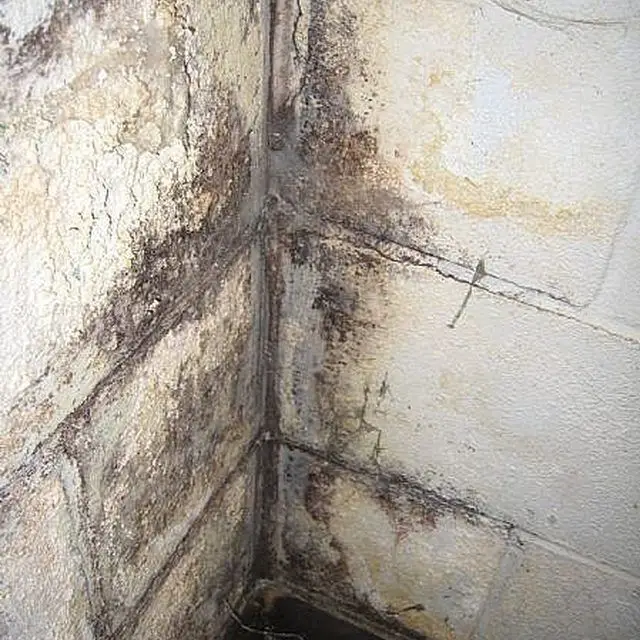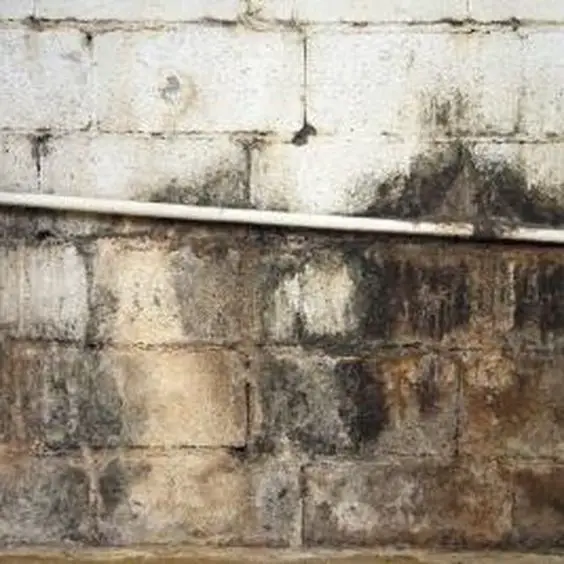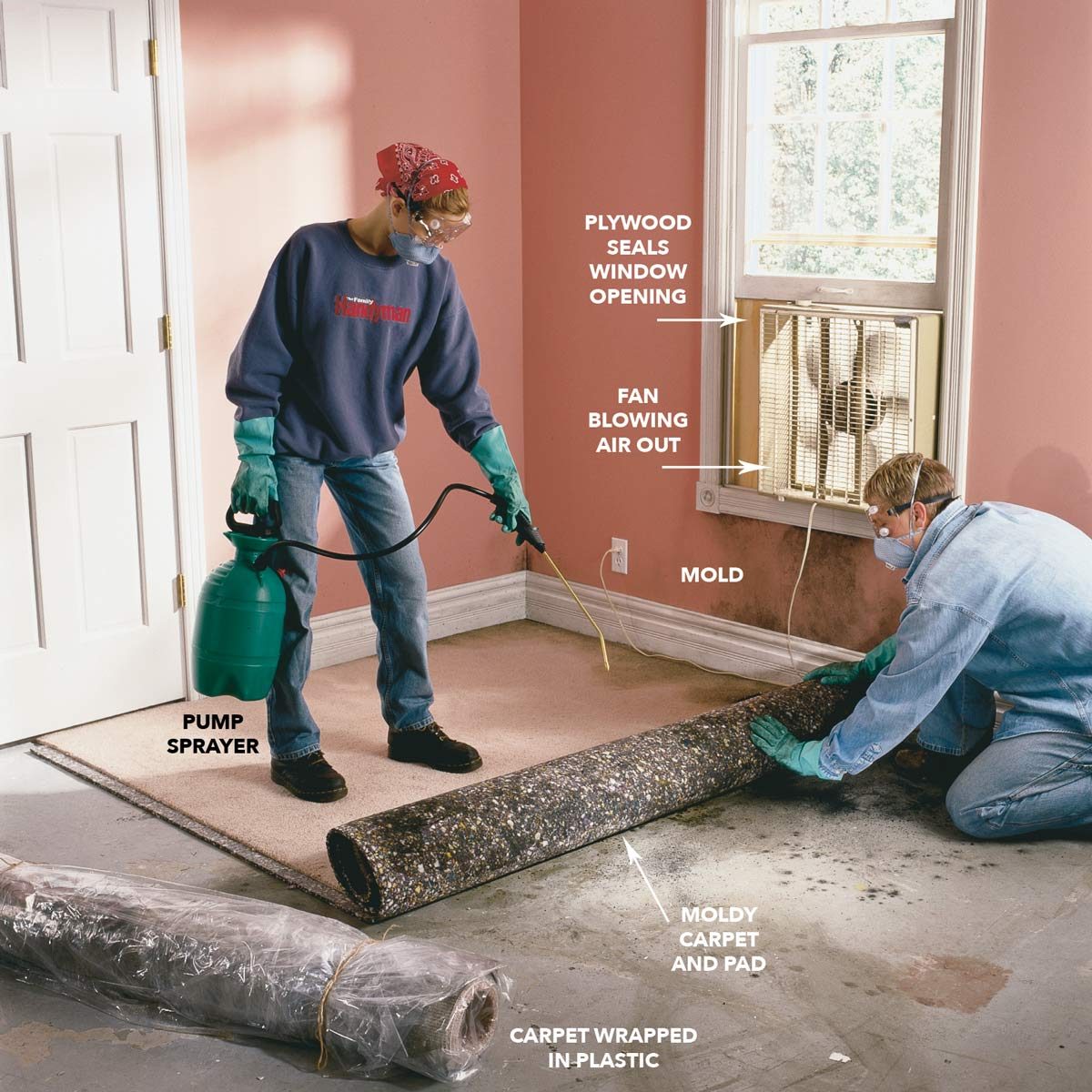Should You Paint Over Mold On Concrete
Painting over mold is never a good idea on any surface. You will spread mold spores while introducing more moisture into the colony, providing further growth. It will look as if it was covered for a few days, and afterward, it will return to an area bigger than before it was painted. Remediation is the correct way to get rid of mold on concrete.
Get Special Gift: Industry-Standard Mold Removal Guidelines
Download the industry-standard guidelines that Mold Busters use in their own mold removal services, including news, tips and special offers:
Why Does Mold Grow On Concrete
Moisture. This is the one variable we can control when dealing with mold. With concrete you have 3 primary avenues for excess moisture.
Liquid water intrusion
If any part of your home is below grade, youve essentially created a giant empty bowl surrounded by water. Without proper drainage and/or a sump pump, the water will eventually make it through the concrete. Large cracks or holes are not necessary. Hydrostatic pressure is quite powerful and can force large amounts of water through hairlines cracks. Liquid water intrusions certainly can cause mold growth, however it is usually quite localized.
Mold growing on concrete beneath failed waterproofing
Humidity based mold growth
Concrete is a poor insulator. During the winter months when the temperature drops, the cool surface of a concrete wall can cause condensation. In time this elevated surface moisture creates an environment conducive to mold growth.
Mold growth on concrete due to humidity is typically diffuse and spread across a large area.
Mold growth on a concrete wall due to excess humidity.
On its own, concrete does not provide a sufficient food source for fungal growth. Unfortunately this is not especially helpful, because like almost anywhere in a building, dust quickly accumulates on the surface. Within this layer of dust large quantities of food sources for mold are present. Therefore, unless the concrete is kept extremely clean, mold growth can occur.
Gather Equipment And Prep For Safety
First, you want to gather your cleaning tools and safety equipment.
Mold can trigger asthma and other allergic reactions in people who are sensitive to mold. For those people, it is best to avoid this activity.
Safety EquipmentFor safety equipment, you want to have gloves, a dust mask rated N95, and safety glasses.
If youre dealing with lots of mold, you will also want a Tyvex suit to protect the mold spores from getting on your clothes.
What Youll Need To Clean Mold
You have several options when it comes to what to use to sanitize the mold.
Hydrogen peroxide or OxiClean will work for generic cleanups. Scrub with a scrub brush.
If you want a deep clean, you can use what the professionals use. RMR-86 is a no-scrub formula.
For large moldy areas, you can use the 2.5 gallon size with a garden pump sprayer or professional spray bottle.
Don’t Miss: How To Determine If You Have Mold In Your House
My Basement Leaked During Heavy Rain And A Towel Was Left On The Floor Upon Removing The Towel The Floor Was Slimy And Black How Do I Clean It Up
Assuming the floor is concrete, spray the area with a Borax/water solution. Clean up the solution and any debris with paper towels.
Occasionally the mold growth will leave behind a stain, even after a vigorous cleaning. The staining is an aesthetic rather than a health issue. If this occurs, steam/pressure cleaning may be necessary.
Recommended Reading: Removing Mold From Shower Ceiling
Remove Loose Dirt And Debris

Sweep or vacuum loose dirt off the surface of your concrete, with one exception: if you have a mold or mildew problem. in your basement. Follow the instructions below for tackling these potential household toxins.
If you are cleaning a patio or driveway, remove and treat any weeds that may have infiltrated cracks.
Don’t Miss: How Expensive Is Crown Molding
What Causes Black Mold On Concrete
Mold can grow on concrete for a number of reasons. Like other types of mold, black mold grows in areas where the conditions are right for them. Black mold will grow on surfaces with high moisture, which may be due to leaks in windows, roofs, pipes, and water tanks. The spores of black mold are transferred from one place to another through wind, animals, or water sources. If a wet concrete surface is exposed to black mold, the mold will thrive. Black mold reproduces quickly, and a small patch of it can multiply within a short time. This means that your concrete surface could be covered in black mold within a short time.
If the concrete is in a basement, the black mold may be caused by a leak from outside or faulty plumbing. Homes with high humidity also tend to have problems with mould growing on surfaces as well. Outdoor concrete, such as a patio, usually grows mildew when it doesnt dry completely after its been soaked. This is typical of concrete thats well shaded.
How To Apply Wet & Forget Outdoor
Applying Wet & Forget Outdoor couldnt be simpler. Just follow these easy steps to rid your sidewalk of ugly growths and roll out the welcome mat for your friends and family!
*To remove moss, be sure to saturate thoroughly to allow the Wet & Forget to reach the mosss root-like structures. To remove lichen, follow these special instructions.
Read Also: How Can You Tell If You Have Toxic Black Mold
You May Like: How To Prevent Mold In Flooded Basement
Use A Pressure Washer
If you have a small amount of mold or algae, you may find that the first two steps of drying out and sweeping the area is enough to remove it. If this is not the case, pressure washing is often quite effective in removing mold and algae from pavers, bricks or concrete.
If you do not have a pressure washer, you can purchase one relatively inexpensively to have on hand for this and future projects. You can also rent one or hire someone to power wash your surfaces for you. If you are pressure washing paving stone patios, walkways or driveways, you may need to replenish the joint sand between the pavers after cleaning them. This is typically included in a professional clean and seal paver service.
Pressure washing is often all you need to remove mold or algae from hardscapes, but if this does not work, there are other options.
How To Pressure Wash Mold On Concrete
Pressure washing is one of the most effective ways to remove the stains and other unwanted build ups on surfaces created by a variety of different things.
One of the most common issues found on many concrete surfaces in particular, is the build up of mold and mildew.
It is important to take action when concrete surfaces are showing signs of mold accumulation, not to have clean looking concrete, but to prevent degradation as well. Mold build up on concrete will cause it to become porous, which in turn will allow moisture to invade and cause damage over time.
Maintaining the integrity of your concrete is incredibly important for many reasons, and should always be a priority.
Lets talk more about this, and provide some useful advice regarding how to safely and efficiently pressure wash mold on concrete.
You May Like: Does Lysol Laundry Sanitizer Kill Mold
Is Black Mold On Concrete Dangerous
Yes, mold on your concrete surfaces can be dangerous. When exposed to large amounts of black mold, some people develop allergic reactions or asthma. People who are not allergic to mold can also experience irritation in their eyes, nose, skin, lungs, throat, or skin. People who are allergic to mold experience symptoms such as a running nose, prolonged sneezing, skin rashes, and red eyes when exposed to it. If one has a severe allergy to mold, he or she might experience severe reactions such as a shortness of breath, and this can be fatal. In some instances, people who have asthma and have developed mold allergy are likely to experience asthma attacks when exposed to mold.
Types Of Basement Mold
Various types of mold will infest your basement. While they are all hideous, not all of them are toxic to humans.
Molds can be divided into two categories:
- Mycotoxin/black
Allergenic molds usually pose no health risk unless you are extremely sensitive to molds or asthmatic. On the other hand, black molds produce a toxic chemical called mycotoxins and are particularly harmful to humans and pets.
Here are the common types of molds that can infest your basement.
Aspergillus
Aspergillus is one of the most common household mold species. There are different types of Aspergillus, and most of them thrive well indoors. Some of the Aspergillus molds are allergenic, but some are mycotoxin and should be removed by a specialist, especially if it is something like black mold.
This fungus is dark green and found on damp walls, ceilings, and even furniture. It flourishes in humid environments, but can also grow in areas that are dry with high levels of humidity or condensation.
Recommended Reading: How To Get Rid Of White Mold On Concrete
What Does Mold On Concrete Look Like
Mold on concrete can look like any number of different things. It depends on what classification of mold is growing on the surface of your concrete. It could be white, black or green.
Mold can be harmless or harmful regardless of color, so you should have a professional from Mold Busters visit your property for an expert inspection.
If you mistake black mold for mildew and try to clean it off, you could spread it to the rest of your home. Certain black molds grow in circular formations and are easy to spot however, this is not always the case.
This mold should be treated in the same way as any mold colony growing inside your home.
How To Remove Green Mold From Concrete

Mold, a common household problem, grows in damp, dark and humid areas. Mold comes in a wide array of colors, including black, brown, purple and green. Green mold is typically found outside the home on structures, walkways and concrete.
Mold, a common household problem, grows in damp, dark and humid areas. Mold comes in a wide array of colors, including black, brown, purple and green. Green mold is typically found outside the home on structures, walkways and concrete. Green mold can create stains and discoloration on your concrete, making the area look old and dingy. Fortunately, it’s possible to remove green mold with a few simple items.
Don’t Miss: Does Sodium Hypochlorite Kill Mold
How To Keep Concrete From Sticking To Wood Forms
There are few settings more ripe for mold growth than a basement. Dark, damp and humid, basements provide the ideal conditions for mold to grow. Concrete walls become mildewed when spores grow on dust, dirt, or painted surfaces. Thankfully, basement mold removal doesnt have to be a struggle, and you can do it yourself with basic supplies and a little patience. You can effectively kill mold with a lot of household supplies like vinegar along with other cleaning solutions commonly found in stores to get rid of any mold stains.
Pressure Washing With Detergent
Don’t want to use bleach? Alternatively, you can use a mold and mildew house and siding detergent that is safe for your pressure washer. It will make your task much easier.
Simply fill your detergent tank, switch the tank to “On,” and begin spraying your concrete with soap. Let it soak into the mold and mildew, and you’ll be ready to spray it away.
Also Check: How Can You Clean Black Mold
Kill Mold Safely With Vinegar
One of the safest DIY cleaners for killing mold is vinegar. Vinegar is a mild acid that doesnt smell particularly pleasant, but it does its job with mildew. However, vinegar does not kill 100% of mold types, so do your research or test a small area before committing to it.
- Baking soda and water solution
To clean mold with vinegar, liberally spray moldy areas with the undiluted white vinegar. Leave it on the moldy areas for at least an hour to penetrate and kill any roots embedded in the walls or floor.
Optionally, you may spray a solution of baking soda and water onto the vinegar-saturated areas to up its mold-killing power. Wipe down the surface with clean water to finish the job. White vinegar is an excellent , too!
If your basement smells like sewage, you may have a clog in the drain in the floor or in the toilet in the bathroom. Pour a mixture of vinegar, water, and baking soda into the drain to release the clog and quickly eliminate that sewage smell in the basement.
Repeat applications may be necessary if the clog does not break up the first time. However, after the clog clears, your basement will smell fresh and clean again.
Apply An Acrylic Sealer
Applying an acrylic sealer on concrete is an excellent way to protect driveways and patios for years to come. It sticks to the surface as a protective layer that prevents mold spores and water from penetrating the pores, thereby keeping it free from mold, mildew, algae, and moss.
KILZ L390201 Interior/Exterior Concrete, Brick, and Tile Liquid Masonry Sealer
A high-quality concrete, brick, and tile masonry sealer brought to you by the leading mold-resistant paint company KILZ.
Just one coat on your patio or driveway will protect it from mold, mildew, and stains for years without fading the colors.
The product can be applied on clean surfaces that are free of dust and mold through a pump sprayer, brush or roller, and dries within an hour. Also, one gallon of this concrete acrylic sealer can cover up to 400 square feet.
Get the latest price from .
You May Like: Can Drinking Mold Make You Sick
How To Remove Dog Urine Stains
Step By Step Instructions For How To Remove Dog Urine Stains From Concrete
You May Like: How To Rid Black Mold
Grease And Oil Stains
To clean oil from concrete, sprinkle sawdust, cornmeal, or baking soda directly onto the stain to absorb as much of the spill as possible. Once the spill is absorbed, brush away the remaining powder with a broom.
If a stain remains, sprinkle more baking soda and scrub the stain with a nylon brush and a little bit of water. Not all is lost if the oil stain is old or has penetrated the surface to help remove residual grease stains, try a degreaser and follow the manufacturers instructions.
Also Check: How To Get Rid Of Airborne Mold In House
How To Remove Mold From Concrete Basement Walls
- Written by Cameron Sherber on Apr 09, 2010To ensure our content is always up-to-date with current information, best practices, and professional advice, articles are routinely reviewed by industry experts with years of hands-on experience.Reviewed by
If your concrete basement walls have recently fallen victim to mold infestation, you may be wondering how to go about getting rid of it. Below are the necessary steps to remove such an infestation from your home.
Step 1 – Clean Your Basement Walls
Before you can begin the mold removal process, you must give your concrete basement walls a thorough cleaning. Begin this step by combining warm water with a mild brand of soap. Next, pour the newly formed cleaning solution into an empty spray bottle and proceed to vigorously apply it to your mold-laden basement walls. You’ll now need to use a sponge or scrub brush to wipe the walls clean, taking care to fully purge any caked-on dirt deposits. Any remaining dirt or debris stands to cause problems when the mold removal process is underway, so when performing this step, take your time. Once your walls have been sufficiently cleaned, you’ll be ready to move on.
Step 2 – Apply Your Bleach
Step 3 – Apply Your Finishing Touches
How To Remove Mold From Concrete Patio: 6 Options

Unfortunately, cement mold removal is sometimes more involved than power-washing away all visible evidence of the fungus and calling it a day. Because individual spores are invisible and can begin to repopulate the entire area rapidly, its important to truly cleanse black mold off cement in its entirety or make sure it is killed at the root, so here are six full-proof ways to eliminate mold from any concrete surface.
Also Check: What To Do After Breathing In Mold
Will Vinegar Damage Concrete
Cleaning concrete with vinegar will not damage it! However, saturating concrete for an extended period will damage the cement that binds concrete together. Over time, vinegar erodes the concrete itself, so be careful.
Take extra care with polished concrete, as a chemical reaction might take place between the vinegar and cement, causing salt and erosion to form. This eats away at your cement and, in turn, your concrete.
Overall, cleaning concrete with vinegar is a safe, non-toxic option for many people looking for natural alternatives. It cleans everything from kitchen floors to garages and driveways or equipment covered in concrete.
Vinegar even cleans tile grout but remember that vinegar cleans concrete by scraping off tiny layers of cement in the process. Only use it if you dont mind rubbing off a top microscopic layer to your surface.